Bats are typically found living in relatively large colonies, so it is not a great challenge for them to find one another for mating. Typically, male and female bats remain segregated unless it is time for them to mate. Once female bats become pregnant, roughly 100 or so form a maternity colony which encompasses a sub-area of the entire bat colony. Breeding for bats occurs mostly during the spring when the temperature becomes warm. This is also the time of the year when bats are able to obtain the most food supplies. Although there is only one actual breeding season, female bats may deliver 1 to 3 litters during this time frame, birthing a single bat at a time. It may become a difficult struggle for bat mothers to properly care for their young. The mother must be able to fly and hunt for food while pregnant. In the meantime, the infant bat will drink milk from the mother’s body. Newly born bats do not yet have fully developed wings, but once they develop the bats leave their mothers and venture out on their own to look for their own food. The mother only spends time with her young between six weeks to four months of age.
Most bats are insectivorous (70%), most commonly flying and hunting down insects for food. In fact, the bat is the only true mammal that can really fly. In order to locate these insects, bats use echolocation. The bat releases a “feeding buzz” as it homes in on an insect. Bats may also feed on ground prey such as frogs, some reptiles, rodents, and even small birds. There are also less common fruit bats which eat things such as mangoes and drink the nectar of flowers. Bats are nocturnal creatures, therefore all of their food hunting occurs during the night time. There are almost 1000 bat species known to us, thus the varied eating habits of some of them include peculiar foods such as scorpions or even nectar from hummingbird feeders. There is even a species of bat, known as the long-eared desert palid bat, which has become immune to the venom of scorpion stings as an adaptation to this bizarre eating habit. Snakes, owls, and hawks are all known predators that bats need to look out for in the wild.
References & Works Cited:
Wilson, Don E. Bats in Question: The Smithsonian Answer Book. Washington D.C.: Smithsonian Books, May 1997.
Allen, Glover Morrill. Bats: Biology, Behavior and Folklore. New York, Dover Publications, November 2004.
Bat Reproduction http://www.batworlds.com/bat-reproduction
Post by Rolland Bogacz, Fourth-Year, Urban and Environmental Planning

